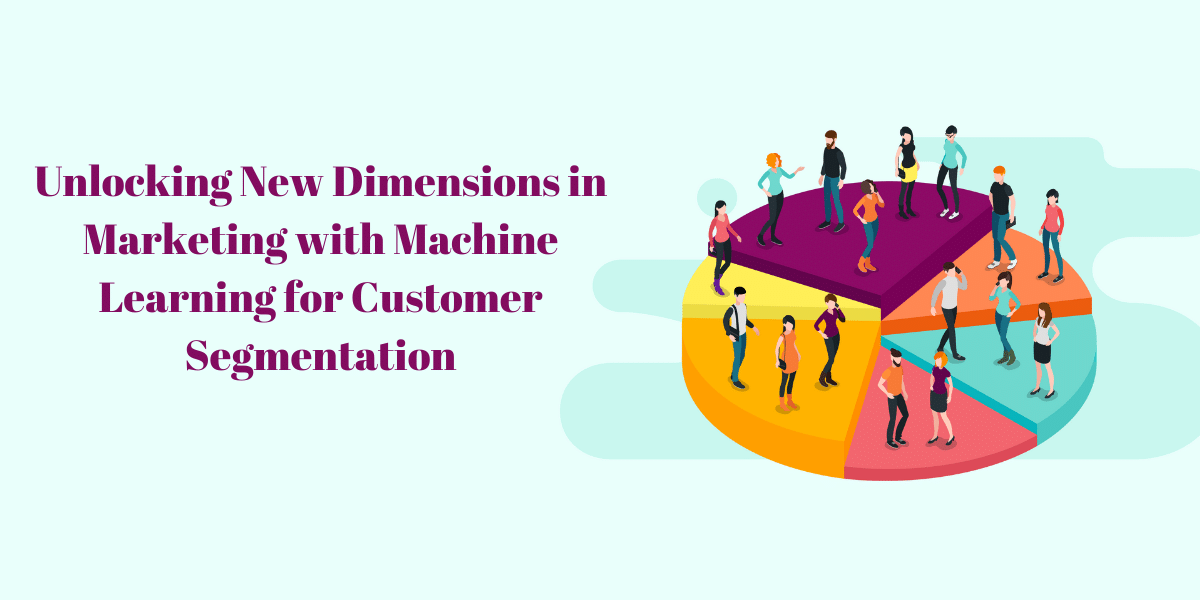In the rapidly changing digital environment, marketing and machine learning fusion have revolutionized how companies interact with their clients. The old segmentation methods are replaced by sophisticated algorithms that analyze huge amounts of data to discover specific patterns and behaviors. This paradigm shift gives marketers a wealth of information about their intended audience, allowing them to develop incredibly accurate strategies.
Machine learning development methods allow marketers to anticipate their customers’ preferences, customize campaigns, and increase performance in ways that were previously impossible to imagine. In the race to stay ahead of the curve in extremely competition-driven markets, the capability to uncover new facets of marketing by using machine learning is no longer just an advantage in competition; rather, it is a necessity.
This article sets the scene for examining the transformative effect of machine learning on customer segmentation and revealing the path to more efficient, effective, and compassionate marketing strategies in the modern age.
The Evolution of Customer Segmentation
Segmentation is the process of splitting a customer base into groups of the same characteristics. It has long been the foundation of marketing strategies. The traditional method of segmentation relied heavily on general demographic categories like gender, age, and income level. However, as markets grew complicated and customer behavior became more complex, traditional methods of segmentation were unable to capture the range of preferences and motives.
The development of customer segmentation can be traced back to advances in data collection and analysis. Due to the rapid growth of digital technologies, companies gained access to a wealth of customer information, including purchases, online behavior, and social media interaction. This vast amount of data opened an avenue for advanced segmentation methods powered by machine learning algorithms.
When machine learning algorithms began become more popular marketing professionals realized the possibility of more specific and fluid segmentation. In contrast to static demographic categories machine learning allows segmentation based on a myriad of factors that include behaviors as well as preferences and interactions. The transition from static segmentation to dynamic is a radical change from the traditional methods that allow marketers to adjust their strategies at a moment’s notice according to the changing dynamics of their customers.
Additionally, machine learning allows the discovery of hidden patterns and relationships in data sets that might not be evident through conventional analysis techniques. With the power of predictive analytics, businesses are able to predict trends in the future and anticipate customer behaviour, which allows proactive instead of reactive strategies.
Understanding the Power of Data in Marketing
In this age of digitalization data has become the vital ingredient of marketing, offering valuable insight into the behavior of customers patterns, preferences, and trends. Every interaction, offline or online, leaves an accumulation of data that is crucial to knowing and anticipating the needs of customers. But, the amount and complexity of data poses a major obstacle for marketers who want to gain actionable insights.
Data-driven marketing leverages the power of advanced analysis and machine learning algorithms to understand this plethora of information. Through aggregating and analysing information from various sources, including websites, social media and transaction records marketers can discover the patterns or trends which offer important insights into the behavior of customers.
One of the major benefits that data-driven marketing has is its capacity to improve targeted and segmentation strategies. Instead of relying on broad groups of people marketers can use data to develop more specific profile of customers based on personal preferences, habits and preferences. This enables more customized and relevant communications strategies, resulting in greater engagement and higher conversion rates.
Additionally, data-driven marketing allows marketers to assess the efficacy of their campaigns with remarkable precision. By monitoring the performance indicators of key importance (KPIs) like conversion rates, click-through rate and the lifetime value of customers marketers can measure the performance of their efforts in real-time, and adjust their strategies based on data to improve outcomes.
Machine Learning Techniques for Customer Segmentation
Machine learning techniques can provide various methods and techniques to help segment customers, allowing marketers to discover patterns that are hidden and reveal insights in massive data sets. These methods employ algorithms and mathematical models to discover relationships and correlations between different data points which allows for more precise as well as dynamic segments.
A popular and commonly employed machine learning techniques used for segmenting customers can be clustering. Clustering algorithms put similar data points using predefined criteria like similarity in purchase behaviour or demographic attributes. This technique allows marketers to recognize distinct segments within their client base, each with distinct traits and preferences.
Another machine learning technique that is highly effective to help segment customers is classification. Classification algorithms divide data into categories or classes according to their characteristics. For instance, marketers could make use of classifiers to determine churn of customers or to identify customers with high value using the past data and patterns of behavior.
Furthermore, machine-learning techniques like decision trees neural networks or support vector machine could also be used to segment customers each of them has distinct advantages, based on the scenario and data.
One of the major advantages of machine learning methods for segmenting customers is their capacity to change and develop as time passes. In contrast to traditional methods of segmentation that can become obsolete when consumer preferences change machines learning algorithms constantly improve and learn with new data, which ensures that the strategies used to segment customers remain useful and efficient.
Predictive Analytics: Anticipating Customer Behavior
Predictive analytics, aided by machine-learning algorithms, allows marketers to predict future trends and patterns in customer behavior with a remarkable degree of precision. By analysing past records and discovering patterns and relationships predictive analytics enables marketers to make predictions based on data regarding the future including purchasing behavior or preferences for products, as well as the risk of churn.
One of the most important uses of predictive analytics in marketing is predicting customer churn. By studying historical data regarding customer interactions, purchases and engagement metrics marketers can spot early warning signs that indicate the possibility of a customer’s churn. Armed with this knowledge marketers can devise specific retention strategies that will reduce the likelihood of churn as well as maximize the value of a customer’s lifetime.
Another major use that predictive analytics can be used for is the ability to provide personalized product suggestions. Through analyzing the purchase history of previous customers as well as browsing habits, marketing are able to create personalized recommendations that are tailored to each customer’s specific preferences and needs. This is not just beneficial to the user experience, but it also increases the probability of repeat purchases as well as cross-selling opportunities.
Additionally, predictive analytics can be utilized to optimize marketing strategies and allocation of resources. Through the analysis of previous campaign results and other external factors, such as the trends in the market and activity of competitors marketers can anticipate the effects of various strategies and efficiently allocate resources in order to maximize the return on investment.
Enhancing Engagement with Customers by Machine Learning
Machine learning plays an essential part in increasing customer engagement, allowing marketers to provide customized and relevant experiences at multiple points of contact. One way that machine learning accomplishes this is via predictive analytics, which analyses the past behavior and interactions to predict future actions. Through understanding the preferences of customers and predicting their preferences marketers can adjust their messages and promotions to be a hit with specific customers, thereby increasing satisfaction and increasing loyalty.
Another method by which machine learning can improve customers’ engagement by using analysis of sentiment. By studying the content of social media, reviews from customers as well as other unstructured sources of data, machine learning algorithms can provide information about customer sentiment and perception. Armed with this information marketers can spot ways to address issues and take advantage of positive sentiment and adapt their message to appeal to their target audience at a deeper level.
In addition, machine learning allows marketers to automate and enhance strategies for engagement at a large scale. With techniques like neural process of language (NLP) as well chatbots companies can provide individualized interactions and help to customers in real-time regardless of which channel they decide to use. This improves not only the overall experience for customers, but also boosts effectiveness and speeds up response times.
Furthermore, machine learning allows the optimization of content in a dynamic manner, which allows marketers to refine and test their messages in real-time, in response to feedback from customers and behaviour. Through continuous analysis of the data on performance and adapting their content to suit, marketers can make sure that their messages are relevant and memorable, leading to greater engagement and higher conversion rates.
Targeted advertising with segmented Audiences
The concept of targeted advertising is an integral part for modern strategies to market as machine-learning plays a vital role in enhancing the efficacy of these campaigns through enabling marketers to discover and target audiences segmented precisely. Instead of employing a generic method, targeted advertising utilizes data-driven information to tailor the messages and offers for certain segments of audiences according to their demographics, interests and behaviours.
Machine learning algorithms are adept at studying huge quantities of data to find patterns and connections, making them indispensable tools to segment audiences efficiently. By studying historical data on the customer’s interactions, purchasing behavior and demographics, the algorithms for machine learning development can pinpoint distinct audiences with distinct traits and habits.
One of the main advantages of targeted ads with segments is the ability to enhance the relevance of advertisements and increase engagement. Through delivering targeted messages and offers that are resonant with the different segments of an audience marketing professionals can draw interest, encourage clicks and improve the conversion rate. This is not only maximizing the effectiveness of advertisements but also improves the overall experience for customers by providing relevant content to the right audiences at the right moment.
Additionally, targeted advertising permits marketers to optimize their advertising spend and return on investment by focusing their efforts on the most valuable audience segments. By prioritizing the segments that have the highest probability of conversion (or lifetime value), advertisers can make better use of their resources and get more results for less money.
Customer Lifetime Value Prediction
Knowing and predicting customer life-time value (CLV) is crucial for companies looking to maximize the value of their marketing investment and allocate resources in a way that is efficient. Machine learning provides powerful tools and algorithms to predict CLV with precision, allowing marketers to recognize high-value customers and adapt their strategies and increase long-term profits.
Machine learning algorithms analyse the historical data of customers, such as purchases, frequency of transactions as well as average order value and the length of time customers have been with them to find patterns and trends which are correlated with the future CLV. With these data points, marketers can build predictive models to predict the anticipated revenue of each customer’s lifespan, allowing marketers to allocate resources efficiently and adapt strategies to suit.
One of the major advantages of CLV prediction using machine learning is its capacity to recognize the most valuable customers and allocate resources efficiently to maximize their value over the course of their lives. When identifying customers who have the highest likelihood of long-term profit, marketers can make customized deals, loyalty programs and retention strategies that help to build these relationships and encourage frequent purchases.
Furthermore, CLV prediction enables marketers to improve retention and acquisition efforts by focusing their resources on the segments that offer the greatest possible ROI. By identifying customers who have a high CLV predicted and who are in danger of losing their customers marketing professionals can develop targeted retention strategies to reduce the risk of losing customers and increase their contribution to the company.
Harnessing Big Data for Marketing Insights
Big data has transformed the field of marketing through offering access to massive quantities of unstructured and structured information that could be examined to uncover valuable information. Machine learning plays an essential role in harnessing big data to marketing objectives by allowing marketers to gain actionable insights from huge data sets. Utilizing machines learning techniques, marketing professionals are able to discern patterns, trends, and relationships within big data sets, which allows them to take data-driven decisions and enhance their marketing strategies to maximize impact.
One of the major benefits of utilizing big data to gain marketing insight is the ability to offer a broad overview of the behavior of customers across various channels and points of contact. By aggregating data from various sources like websites, social media and Customer relationship management (CRM) systems and transaction records, marketers will gain a comprehensive knowledge of their customers their preferences, interests and behavior. This more detailed understanding allows marketers to customize their strategies to be more effective and deliver personalized experiences that appeal to individual customers.
In addition the use of big data analytics fueled by machine learning can reveal new insights and opportunities that aren’t obvious using conventional analysis techniques. Through the analysis of large amounts of information in real time, marketing professionals can detect emerging trends, forecast the future, and take advantage of opportunities for growth and innovation. The proactive method of making decisions based on data allows marketers to remain ahead of the pack and benefit from market dynamics.
Making Marketing Campaigns more Efficient Using Machine Learning
Automation has gotten more common in the field of marketing, with machine learning playing a major part in streamlining processes, improving performance and increasing efficiency. Machine learning algorithms are able to automate different areas of marketing strategies, ranging from audience segmentation and targeting, to optimizing and personalizing content. Automating repetitive tasks, and drawing on information derived from data, marketers can spend their time and money to strategic strategies that produce outcomes.
One of the main advantages of automating marketing campaigns by using machine learning is the capacity to boost effectiveness and scalability. Automating tasks like audience segmentation, personalizing emails and optimizing campaigns marketers are able to streamline their workflows and decrease efforts to manually manage, and also expand their efforts across a variety of platforms and touchpoints. This allows the marketers to connect with a broader population, provide more customized experiences, and achieve better results while requiring lesser effort.
Additionally machines learning algorithms are able to improve marketing campaigns in real time by adjusting strategies and tactics in response to changes in market conditions as well as customer behaviour and the performance metrics. Through continuous analysis of the data and continually improving campaigns, marketers are able to increase their effectiveness and get more effective outcomes over time. This method of continuous optimizing campaigns allows marketers to remain flexible and adaptable in today’s highly-connected digital world.
In addition, automation can improve the effectiveness and accuracy of marketing campaigns by using the power of predictive analytics as well as machine-learning algorithms. Through the analysis of the historical data and discovering patterns and trends machine learning algorithms can forecast the future results and recommend best strategies to achieve the desired goals. This allows marketers to take data-driven decisions and to achieve more effective results, with less guesswork.
Dynamic Pricing Strategies using Machine Learning
Dynamic pricing, which is the process of altering prices in real time according to the market, demand, and other elements it is now more prevalent across various industries due to the power of machine learning. Machine learning algorithms allow companies to study huge amounts of information, including the pricing of competitors, the behavior of customers and market trends to enhance pricing strategies and increase revenues.
One of the major benefits of dynamic pricing based on machine learning is the ability to react quickly to changes in demand and market conditions. Through constant analysis of data and finding patterns, machine learning algorithms can adjust prices in real time to reflect changes in competition pricing, demand as well as other variables. This allows businesses to extract the most value from every transaction, and to remain at the forefront of a rapidly changing market.
Additionally machine learning algorithms can adapt pricing strategies to the individual preferences and habits of customers. By analysing customer data and segmenting their audiences, businesses can adapt pricing and promotions to certain segments of customers, increasing probability of conversion and increasing the value of a customer’s lifetime.
In addition, dynamic pricing based on machine learning allows businesses to maximize profit and revenue by identifying price thresholds and demand elasticity. Through analyzing the past and performing predictive analyses machines learning algorithms are able to determine the best price point that will maximize revenues while maintaining customers’ satisfaction and competitiveness.
Creating Effective Customer Personas
Customer personas, or fictional depictions of ideal customers based on behavioral, demographic, and psychographic traits are a valuable tool for marketing strategy creation. Machine learning plays an essential part in the creation of effective customer personas through the analysis of huge quantities of data to determine typical characteristics, preferences and patterns of behavior among targeted audiences.
One of the main benefits of constructing customer personas using machine learning solutions is the ability to find hidden insights and patterns in datasets. By studying a variety of data sources including demographic data and purchase history, as well as interaction on websites and social media interaction machine learning algorithms are able find commonalities and patterns among customers, which allows marketers to build more accurate and precise personas.
Additionally machine learning algorithms are able to divide audiences more efficiently and continuously than conventional methods based on defined parameters. Utilizing algorithmic clustering as well as predictive analysis, advertisers are able to discern distinct segments within their intended audience based on their behavior, preferences and many other variables, which allows to develop more personalised and pertinent methods of communication.
In addition, machine learning allows marketers to continually modify and update their customer personas in real-time based on information and feedback. Through analyzing interactions with customers and responses, machine-learning algorithms can detect shifts in preferences and behavior which allows marketers to modify their strategies and personas accordingly to ensure their relevance and effectiveness.
Real-Time Customer Segmentation
Real-time customer segmentation, which is the process of separating clients into different groups according to their preferences, behavior and actions in real-time, is vital to provide customized and relevant experiences to customers at various points of contact. Machine learning facilitates real-time segmentation of customers through the analysis of streams of data in real-time and continuously adjusting the segments based on changing circumstances.
One of the main advantages of real-time segmentation of customers by machine learning is the ability to quickly respond to changes in behavior and market changes. Through continuous analysis of data streams such as purchases, website interactions and social media interaction machines learning algorithms are able to discern trends and patterns in real-time which allows marketers to segment their customers’ needs on the spot and provide personalized experiences in the present.
Additionally it allows marketers to tailor their messages and offers based on their customers’ desires and needs. By segmenting customers at real-time, marketers can adjust their communications strategies to be in tune with the various segments of their audience increasing the chances of engagement and converting.
Additionally real-time customer segmentation utilizing machine learning allows marketers to enhance their marketing strategies and allocate resources in real-time. By identifying the most valuable segments as well as allocating the resources in accordance with them marketers can enhance the effectiveness of their campaigns and obtain more results for less money.
Sentiment Analysis for Better Marketing Communication
It is also referred to as opinion mining is an incredibly powerful machine learning technique that allows businesses to analyse and comprehend the opinions, attitudes and feelings that are expressed in textual data. In the field of marketing, the use of sentiment analysis is a key element in assessing customer satisfaction and identifying trends. It also plays a significant role in forming strategies for communication.
One of the major advantages of the use of sentiment analysis for marketing is it’s capability to give real-time insight on customer perceptions and sentiments. Through the analysis of reviews from customers and social media posts as well as other types of content created by users machines learning algorithms are able to discern positive, negative, and neutral feelings that are expressed about products, brands, or service. This enables marketers to observe the sentiment of their customers, pinpoint areas of improvement and quickly respond to feedback from customers.
Additionally, the analysis of sentiment can help inform strategies for marketing communications by helping marketers comprehend the triggers for emotion as well as the preferences of their targeted audience. Through analyzing the emotional response associated with different content and messages marketers can modify their strategies for communication to resonate with their audiences on a deeper basis increasing engagement and establishing brand loyalty.
Additionally, sentiment analysis can help identify emerging trends and subjects that interest a particular market. Through monitoring trends in sentiment over time, marketers are able to discern changes in consumer preferences as well as anticipate trends in the market and alter their strategies in line with these trends in order to keep ahead market.
Improved Customer Retention via ML
Customer retention, or the capacity to keep existing customers happy and build long-term relationships is vital to sustainable growth of a business. Machine learning provides powerful tools and strategies for enhancing customer retention by identifying risky customers, predicting churn and implementing retention strategies that are targeted.
One of the most important uses of machine learning in customer retention is the prediction of churn. Through the analysis of customer information from the past that includes purchase behaviour metrics for engagement, purchase behavior, and demographic data machines learning algorithms are able to detect the patterns and trends that suggest the likelihood of a customer to leave. With this knowledge marketers can develop specific retention strategies, including customized offers or proactive assistance, in order to reduce the risk of churn as well as increase their lifetime value.
Additionally, machine learning allows marketers to classify customers based on their probability to turn over and adapt retention strategies according to. When they identify high-value customers that have a high risk of being churned, marketers can prioritize their resources and concentrate on retention strategies in areas that will yield the greatest impact, increasing the efficiency of their retention strategies.
Additionally, machine learning can assist in optimizing the retention strategy by discovering most effective methods for different segments of customers. Through analyzing the efficacy of various retention strategies over time the machine learning algorithms will detect certain patterns or trends which will guide the creation of more specific and customized retention strategies, thereby increasing the chances of successful implementation.
Segmenting Customers Across Multiple Channels
In today’s world of omnichannel marketing customers interact with brands via many ways, such as websites and social media, emails and mobile apps. Machine learning lets marketers identify customers across a variety of channels by studying the data collected from multiple touchpoints, in order to identify patterns, preferences and trends that help inform the strategies for targeted communication.
One of the main benefits of separating customers across different channels using machine learning is its capacity to offer a comprehensive overview of the customer’s journey. By aggregating information from various channels and points of contact machines can create profiles of customers which record every individual’s interaction as well as their preferences and behavior throughout the entire customer journey. This allows marketers to provide the same and customized customer experiences regardless of which channel they decide to use.
Furthermore, machine learning allows marketers to spot patterns across channels and correlates that help in determining segmentation strategies. By studying how customers interact across different channels, and identifying commonalities across different segments, they can design more precise and effective segments that can improve the personalization and targeting efforts.
Additionally, separating customers across multiple channels using machine learning allows marketers to enhance their marketing strategies and allocate resources. Through understanding how consumers interact through different channels and various points of contact, marketers can customize their strategies for communication and allocate resources more efficiently to increase ROI and achieve greater outcomes.
Hyper-Personalization: Tailoring Offers in Real-Time
Hyper-personalization is a cutting-edge marketing strategy that leverages machine learning to deliver highly customized offers and experiences to individual customers in real-time. Unlike traditional personalization approaches that rely on static customer segments, hyper-personalization takes personalization to the next level by dynamically tailoring offers and recommendations based on real-time data and customer behavior.
One of the key benefits of hyper-personalization is its ability to increase relevance and engagement by delivering offers that are perfectly aligned with each customer’s preferences and needs. By analysing real-time information like browsing habits as well as purchase history and locations, machine-learning algorithms can provide individualized recommendations and offers that connect with each customer which increases the chances of conversion as well as fostering customer loyalty.
Moreover, hyper-personalization enables marketers to capitalize on micro-moments, fleeting opportunities when customers are most receptive to offers and recommendations. Through analyzing the real-time stream of data and identifying signals that indicate customer intention, such as searches or social media interaction, machine learning algorithms can provide timely and relevant promotions that make use of micro-moments to increase levels of engagement and higher conversion rates.
Furthermore, hyper-personalization allows marketers to optimize customer experiences across various touchpoints and channels. By providing consistent and personal experiences across mobile apps, emails as well as social networks, they are able to provide seamless and seamless experiences across all channels that increase customer satisfaction and loyalty.
Enhancing Customer Experience by ML
Experience with customers (CX) is now a key factor in determining the success of businesses in the current competitive environment Machine learning development solutions are playing an essential role in improving CX by providing personalized smooth, seamless, and easy experiences across different points of contact.
One of the main advantages of enhancing customer experiences by using machine learning is its capability to provide customized experiences that are resonant with the individual customer. Through the analysis of huge amounts of data including previous experiences, preference, as well as behavior patterns machine learning algorithms are able provide customized recommendations, offers and content that are tailored to the individual needs of each customer and preferences, thereby increasing satisfaction and loyalty.
Additionally, machine learning allows businesses to anticipate customer demands and address issues prior to them arising. Through analyzing data from the past and finding patterns and trends, machines learning algorithms can anticipate the future behaviour and preferences of customers which allows businesses to provide prompt support and recommendations to improve the overall experience for customers.
Additionally, machine learning allows companies to streamline their processes and increase efficiency, which results in seamless and smoother customer interactions. Automating repetitive tasks and making use of NLP (NLP) as well chatbots businesses are able to give customers instant personal support and assistance by reducing wait time and improving customer satisfaction.
Machine learning also allows businesses to enhance CX across different channels and touchpoints, resulting in uniform as well as consistent user experiences which improve the perception of brands and increase loyalty.
Forecasting the Customer’s Churn using Machine Learning
The rate when customers stop conducting business with the company is an important measure for companies looking to keep customers loyal and increase profits. Machine learning provides powerful tools and methods to predict customer churn in a precise manner and allowing businesses to recognize those at risk and develop specific retention strategies.
One of the main advantages of predicting turnover with machine learning is its capacity to analyze huge quantities of data to identify the patterns or trends which suggest the possibility of churn. Through analyzing variables such as the behavior of customers or engagement metrics, as well as demographics of customers, machine learning algorithms can detect the early indications of churn, and also predict the most likely customers to go away, enabling companies to take proactive steps to keep the customers they have.
Furthermore, machine learning allows companies to categorize customers based on their probability to turn over and adapt retention strategies according to. By identifying customers with high value that are most at risk of becoming churned companies can prioritize the resources they have and target on their retention efforts in areas on areas where they can have the most impact, and thus increase the efficiency of their retention strategies.
In addition, machine learning could aid in optimizing methods for retention by finding most effective strategies for various segments of customers. By studying the effectiveness of various strategies for retention over time the machine learning algorithms will discern certain patterns or trends which guide the creation of more specific and customized retention strategies, thereby increasing the chance of successful implementation.
Social Media Listening and Customer Segmentation
The process of listening to conversations on social media platforms, which is the process of analyzing and monitoring the conversations and posts in social networks, can be an effective instrument for companies looking to know the sentiment of their customers to identify trends and help inform marketing strategies. Machine learning allows businesses to draw actionable information through social media analytics and to segment customers according to their interests or preferences as well as other behaviors.
One of the major advantages of listening to social media by machine learning is its capacity to give real-time information about the perception and sentiment of customers. Through the analysis of social media conversations including comments, mentions, and other messages machine learning algorithms can detect patterns and trends that show the customer’s perception of the brand, product or service. This enables companies to monitor the sentiment of their customers, pinpoint areas of improvement and react quickly to feedback from customers.
Furthermore, listening to social media allows businesses to find influential people and brand advocates that can assist in boosting their message and make their message more accessible to a wider audience. Through the analysis of the social media information machine learning algorithms are able find people with large followings and high engagement levels and allow companies to reach individuals with customized incentives and promotions to boost their brand.
In addition, the use of social media listening using machine learning allows businesses to categorize their customers according to their preferences, interests, and behaviours. Through analyzing data from social media and identifying commonalities between customers, machine-learning algorithms can produce precise customer profiles which inform the development of targeted marketing strategies and marketing campaigns.
Strategy for Upselling, Cross-Selling Using the use of ML
Upselling and cross-selling are crucial methods for increasing the revenue of your business and increasing the lifetime value of customers and machine learning can provide powerful tools to optimize these strategies by identifying opportunities, and making offers that are specific to each customer.
One of the major advantages of cross-selling and upselling strategies using machine learning is the capacity to examine huge amounts of data to identify patterns and correlations that suggest potential sales opportunities. Through analyzing variables such as the history of purchases, browsing habits as well as demographic information Machine learning algorithms can find opportunities for cross-selling and upselling which are likely to appeal to specific customers which increases the chances of converting.
Furthermore, machine learning allows companies to tailor sales and cross-selling campaigns according to individual preferences and behaviours. By analysing customer data and separating audiences, machine-learning algorithms can adapt the offers and suggestions to every customer’s individual needs and interests, enhancing the value and effectiveness of upselling and cross-selling strategies.
Additionally machine learning algorithms are able to improve cross-selling and upselling strategies over time by analysing the effectiveness of different strategies and strategies. By analyzing key performance indicators like conversion rates and the amount of revenue earned by machine learning algorithms, they can discern pattern and patterns that can guide the creation of more targeted and individualized strategies, eventually producing better results.
Optimizing Marketing Emails by ML
Marketing via email remains one of the most efficient channels for connecting with customers and keeping them engaged and utilizing machine learning, it provides powerful tools to optimize emails to get greater outcomes. Through the use of data-driven insights and predictive analytics, companies can increase personalization, targeting, and automation to increase the impact of their emails marketing campaigns.
One of the major advantages of optimizing marketing campaigns for email using machine learning solutions is its capacity to enhance the effectiveness of targeting and segmentation. By analysing customer data, like past purchases or browsing history as well as engagement metrics, machine-learning algorithms can be used to segment users more efficiently and determine the most appropriate and responsive segments to send targeted emails. This lets businesses deliver relevant and personalized content that resonates with every person and increases opening rates, click-through rates and conversion rates.
Furthermore, machine learning allows companies to automate and improve the effectiveness of their email marketing campaigns at a scale. Utilizing algorithms to analyze data on performance and adjust campaign parameters in real time and ensure that their marketing campaigns via email are constantly optimized to maximize impact. This can include automating tasks like the A/B test, optimization of content and sending-time optimization, to achieve more efficient results and increase efficiency.
Additionally, machine learning could improve email personalization by generating dynamic content and suggestions in response to individual preferences and behaviours. By analysing data in real time and predicting the needs of customers and preferences machines learning algorithms are able to adapt email content to the individual’s preferences which increases engagement and conversion.
Streamlining Customer Service with ML
Customer support is a crucial element of customer satisfaction, and machine learning provides powerful tools to streamline and improving support processes to offer speedier, more personal and efficient support. Utilizing natural processing of language (NLP) chatbots, chatbots or predictive analytics companies can automate repetitive tasks, offer immediate support and anticipate the needs of customers to boost customer the level of satisfaction as well as loyalty.
One of the major advantages of streamlining customer service through machine learning is the ability to provide immediate personal support to customers using bots, chatbots or virtual assistants. By analysing customer requests in real-time, and then generating automated responses that are based on predefined guidelines and pattern, machine-learning algorithms can offer instant assistance and solve common problems without human intervention. Businesses can provide 24/7 support, cut down waiting times and boost the customer experience.
Furthermore, machine learning allows companies to anticipate the needs of customers and address issues in advance of they occur. Through analyzing the historical data on support and finding patterns and trends, machines learning algorithms can forecast the future needs for support and suggest proactive steps to avoid problems and reduce disruptions to customer experience.
Additionally, machine learning can improve support processes through automation of routine tasks like the routing of tickets, issue categorization and prioritization of responses. Through the use of algorithms to analyse the data, and then make decisions real time companies will ensure support inquiries are effectively and efficiently dealt with by reducing resolution time and increasing overall quality of service.
All in all, streamlining client service by using machine learning gives businesses the ability to deliver quicker, more customized and efficient customer support services. Through the use of NLP chatbots, chatbots, as well as predictive analytics companies can automate repetitive tasks, offer instant assistance and anticipate customer demands to boost satisfaction and retention in today’s rapidly changing digital environment.
Fraud Prevention and Detection with Machine Learning
The detection and prevention of frauds is a major concern for companies across all industries Machine learning is one of the most effective tools for identifying and reducing fraudulent activity in real-time. Through the analysis of huge amounts data and identifying the patterns or anomalies machine-learning algorithms can aid businesses in detecting fraudulent transactions, limit losses in financial terms, and safeguard their brand’s reputation and integrity.
One of the major advantages of fraud prevention and detection through machine learning is the ability to analyse large amounts of transaction information in real-time and spot patterns and irregularities that could indicate fraud. Through the use of algorithms that identify unusual patterns like sudden spikes in the volume of transactions or a change in purchasing habits Businesses can detect suspicious transactions to further investigation. They can also implement proactive measures to avoid fraud.
Additionally, machine learning allows companies to constantly modify and enhance their fraud detection strategies as time passes. Through analyzing the past data and taking into account feedback from previous fraud cases machines learning algorithms learn from past experiences and grow more accurate and effective in identifying fraud as time passes. This method of fraud detection allows businesses to keep ahead of scammers and safeguard their customers and assets from harm.
Additionally, machine learning could assist businesses in reducing false positives and increase the effectiveness of fraud detection by studying additional data from the context of the transaction and applying advanced analytics techniques like prediction modeling and anomaly detection. By analyzing a wider variety of variables and using predictive analytics, businesses are able to discern suspicious patterns and behaviours more effectively and lower the risk to detect false alarms.
Personalized Product Recommendations
The ability to tailor product recommendation is a crucial strategy to increase sales and improving the customer experience. Machine learning is a powerful tool to create highly targeted and relevant recommendations based on customers’ preferences and habits. Through analyzing huge amounts of data and finding patterns and relationships machine learning algorithms could aid businesses in providing specific recommendations that improve the level of engagement, conversion rates and overall satisfaction with customers.
One of the major advantages of personalised product recommendations using machine learning is its capacity to study customer information and create recommendations customized to the specific needs of each person’s preferences and needs. Through analyzing variables such as the past purchases or browsing history as well as demographic data machines learning algorithms are able to find products that are the most likely to be popular with every customer and increase the chances of conversion, and ultimately driving sales.
Additionally, machine learning allows companies to provide customized recommendations across a variety of channels and touchpoints, such as mobile apps, websites emails, as well as social media. Utilizing algorithms that analyze data in real-time, and then adapt recommendations based on the customer’s interactions, businesses can provide consistently seamless and smooth experiences to increase the level of engagement and loyalty.
Additionally, machine learning can assist businesses in optimizing their product recommendations over time, by studying performance data and taking customer feedback. Through constant refinement of recommendation algorithms in light of the results of previous interactions companies can increase the effectiveness and relevance in their suggestions, resulting in greater conversion rates and enhancing customer satisfaction.
The Key Takeaway
In the end, machine learning has revolutionized marketing by enabling companies to uncover new levels of the segmentation of customers, their engagement and satisfaction. By using sophisticated algorithmic techniques and advanced predictive analytics machine learning solutions enables marketers to study huge amounts of data, uncover valuable insights, and create individualized experiences that appeal to individuals.
From separating customers into multiple channels to optimizing campaigns for marketing and predicting behavior of customers Machine learning can provide numerous applications that can help companies achieve higher performance, boost efficiency, and establish long-lasting relationships with their clients. As technology advances machines learning within marketing will expand, enabling companies to stay ahead the competition, be able to adapt to the changing dynamics of markets and deliver better customer experience in today’s dynamic digital world.
The adoption of machine learning technologies is vital for companies that want to succeed in the current age of marketing, in which personalization, relevance and customer-centricity are the key elements of successful business.











